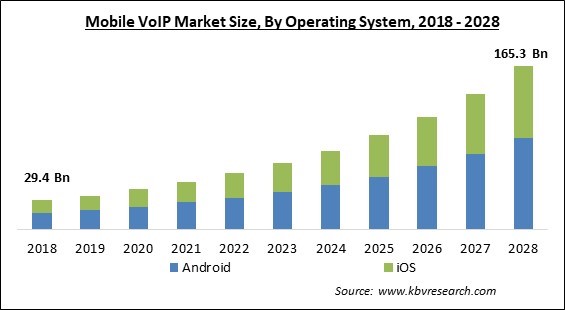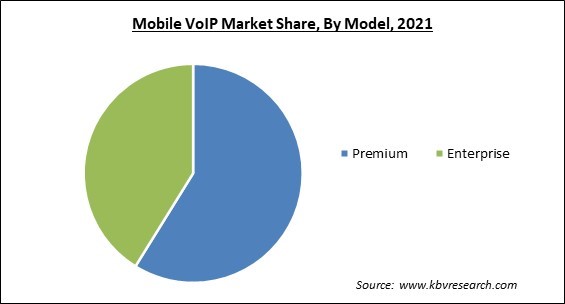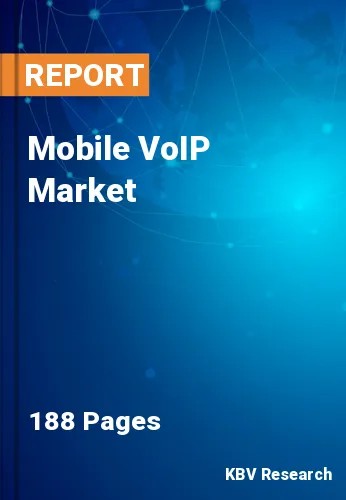The Global Mobile VoIP Market size is expected to reach $165.3 billion by 2028, rising at a market growth of 19.5% CAGR during the forecast period.
Mobile voice-over internet protocol (VoIP), commonly referred to as mobile VoIP (or mVoIP), is a practical and affordable way to communicate via mobile devices like smartphones and tablets. Utilizing GSM, 3G, 4G, or any other internet services on mobile devices helps the mobile VoIP users interact effectively. Whether calling, chatting, or participating in video conferences, users can save costs using mobile VoIP.

Additionally, due to the fact that digital data is separated into packets and that each packet takes the shortest path, VoIP allows for faster transmission of digital data. Among other benefits, mobile VoIP customers can benefit from free roaming, limitless texting, and affordable incoming call rates. By installing mobile VoIP software, users have access to mobile VoIP services.
VoIP, often known as IP telephony, is a technique and collection of technologies for delivering voice conversations and multimedia presentations over IP networks, including the internet. The provision of communications services like voice, fax, SMS, and voice messaging through the internet as opposed to the public switched telephone network (PSTN), generally known as plain old telephone service (POTS), is explicitly referred to as broadband telephony.
Some other names for this service are internet telephony and broadband phone service. Users of mobile devices can use mobile VoIP through either the built-in dialer on their phone or a third-party app they have downloaded. As more and more customers choose to make calls using their smartphones or mobile devices, the technology has proved advantageous for many enterprises and individuals and is growing in popularity.
The pandemic increased the number of individuals working from home, which has boosted the requirement for mobile VoIP services. These services have also grown in popularity as more companies look for affordable communication alternatives. The pandemic, in general, increased demand for digital dependence, and this result is likely to remain as the utility of abundant data and the declining transaction fees of utilizing that data affect how businesspeople, policymakers, and professionals make adjustments. Additionally, the pandemic is only one-factor influencing present patterns. Other important factors are social welfare, sustained economic growth, demographic changes, and climate responsibility.
The market is expanding as a result of the surge in the need for mobile VoIP services among businesses seeking to replace old networking services and provide greater bandwidth communication networks among industries. Additionally, a web-enabled ecosystem has been developed as a result of the adoption of smart technologies across smart devices. High-speed internet also encourages consumers to buy smart and connected items, and mobile VoIP services are being further stimulated by the widespread use of high-speed network architectures and falling data rates. Therefore, as the demand for connected devices increases, it will propel the expansion of internet requirements and, thus, significantly aid in propelling the growth of the mobile VoIP market.
The rise in popularity of innovative and user-friendly programs like WhatsApp, which improve the usefulness of smartphones in terms of connectivity and communication, augments the increasing demand for mobile VoIP services. Additionally, since communication technology has advanced, there is a greater demand for creative applications in the eCommerce sector. As a result, more people are choosing to make purchases online, and the market is expanding due to a large number of users.
VoIP operates by sending data over the internet. It is a phone call that is placed over digital lines as opposed to conventional telephone lines. Therefore, it can be easily hacked if it is left unprotected because of its online presence. Calls can be recorded, and they may occasionally act as a gateway to servers. Additionally, the mobility and accessibility of VoIP make it challenging for other parties to determine the location of a call's origin. Calls originated from an IP address cannot be tracked using GPS or cell tower information. Despite the fact that most callers do not require this information, this poses a serious problem for national emergency services like 911. Therefore, the possibility of plausible security threats posed by this service is posing as a significant factor that hampers the growth of the mobile VoIP market.
Based on operating system, the mobile VoIP market is categorized into android and iOS. The android segment garnered the highest revenue share in the mobile VoIP market in 2021. The increased demand for smartphones with better features like augmented reality, holographic displays, and bendable screens are responsible for this growth. Although these devices are becoming increasingly popular, manufacturers continually differentiate by creating user interface covers to give users a unique mobile appearance.
On the basis of model, the mobile VoIP market is divided into premium model and enterprise model. The enterprise model segment recorded a significant revenue share in the mobile VoIP market in 2021. The segment's growth is attributable to the enterprise model's skill-based routing strategy that aids in increasing corporate productivity. Unified communications platforms, customer service management software (CSMS), integrated voice response systems (IVR), cloud contact centers, and other technologies are examples of applications of mobile VOIP applications in the enterprise segment.
Based on application, the mobile VoIP market is segmented into video sharing, screen sharing, file sharing, and others. The video sharing segment witnessed the maximum revenue share in the mobile VoIP market in 2021. Mobile video sharing allows the online sending and receiving of real-time video as well as voice calls via VoIP. Users can utilize their cellphones, tablets, laptops, etc. to communicate with those who are thousands of kilometers away in high-quality visual and audio ways. In addition, users can share data, photos, and movies on the internet via video sharing VoIP services. These factors prominently aid in the expansion of the segment.

| Report Attribute | Details |
|---|---|
| Market size value in 2021 | USD 48.4 Billion |
| Market size forecast in 2028 | USD 165.3 Billion |
| Base Year | 2021 |
| Historical Period | 2018 to 2020 |
| Forecast Period | 2022 to 2028 |
| Revenue Growth Rate | CAGR of 19.5% from 2022 to 2028 |
| Number of Pages | 188 |
| Number of Tables | 340 |
| Report coverage | Market Trends, Revenue Estimation and Forecast, Segmentation Analysis, Regional and Country Breakdown, Companies Strategic Developments, Company Profiling |
| Segments covered | Operating System, Model, Application, Region |
| Country scope | US, Canada, Mexico, Germany, UK, France, Russia, Spain, Italy, China, Japan, India, South Korea, Singapore, Malaysia, Brazil, Argentina, UAE, Saudi Arabia, South Africa, Nigeria |
| Growth Drivers |
|
| Restraints |
|
On the basis of region, the mobile VoIP market is analyzed across North America, Europe, Asia Pacific, and LAMEA. The North America segment procured the highest revenue share in the mobile VoIP market in 2021. The significant adoption of smartphones and speedier internet connections are the primary factors propelling the segment's growth. Due to its extensive internet penetration, North America is anticipated to play a significant role in the mobile VoIP market. In addition, it is expected that the use of instant messaging apps will increase service demand in the region. Similarly, it is expected that the business and educational sectors in the region will advance technologically as the VoIP industry matures.
Free Valuable Insights: Global Mobile VoIP Market size to reach USD 165.3 Billion by 2028
The market research report covers the analysis of key stake holders of the market. Key companies profiled in the report include Cisco Systems, Inc., Microsoft Corporation, Rakuten group, Inc., Meta Platforms, Inc., Zoom Video Communications, Inc., 8x8, Inc., Citrix Systems, Inc. (Cloud Software Group, Inc.), Ribbon Communications, Inc., 3CX Phone System, and Mitel Networks Corporation.
By Operating System
By Model
By Application
By Geography
The global Mobile VoIP Market size is expected to reach $165.3 billion by 2028.
Growth in the use of smart devices and strong internet connectivity are driving the market in coming years, however, Strict regulatory laws due to possible security threats of mobile VOIP restraints the growth of the market.
Cisco Systems, Inc., Microsoft Corporation, Rakuten group, Inc., Meta Platforms, Inc., Zoom Video Communications, Inc., 8x8, Inc., Citrix Systems, Inc. (Cloud Software Group, Inc.), Ribbon Communications, Inc., 3CX Phone System, and Mitel Networks Corporation.
The expected CAGR of the Mobile VoIP Market is 19.5% from 2022 to 2028.
The Premium segment acquired maximum revenue share in the Global Mobile VoIP Market by Model in 2021 thereby, achieving a market value of $92.4 billion by 2028.
The North America market dominated the Global Mobile VoIP Market by Region in 2021, and would continue to be a dominant market till 2028; thereby, achieving a market value of $57 billion by 2028.
Our team of dedicated experts can provide you with attractive expansion opportunities for your business.

